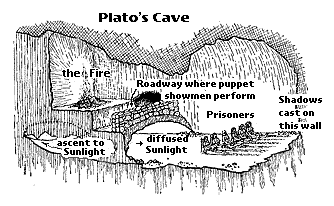The "Allegory of the Cave" by Plato represents an extended metaphor that is to contrast the way in which we perceive and believe in what is reality. The multi-faceted meanings that can be perceived from the "Cave" can be
seen in the beginning with the presence of our prisoners whom are
chained within the darkness of the aforementioned cave. The prisoners
are bound to the floor and unable to turn their heads to see what goes
on behind them. To the back of the prisoners, under the protection of
the parapet, lie the puppeteers whom are casting the shadows on the wall
in which the prisoners are perceiving reality. As Socrates
is describing to Glaucon about the cave and the situation of the prisoners, he conveys
the point that the prisoners would be inherently mistaken as to what is
reality. Because we as readers know that the puppeteers behind them are
using wooden and iron objects to liken the shadows to reality based
items and people, the prisoners (unable to turn their heads) would know
nothing else but the shadows, and perceive this as their own reality.
This is an important development to the story because it shows us that
what we perceive as real from birth is completely false based on our
imperfect interpretations of reality and Goodness. They are actually names of things that are not visible to us, things
that we can only grasp with the mind. This line of thinking is said to
be described as "imagination," by Plato.
Once the prisoner climbs out of the cave
and is fully immersed in the sun's rays, Socrates continues to explain
the prisoner's bewilderment, fear, and blindness to the objects he was
now being told were real. The natural reaction of the prisoner would be
to recognize shadows and reflections. After his eyes adjust to the sunlight, he begins to see items and people
in their own existence, outside of any medium. This recognizes the
cognitive stage of though. The prisoner now is aware of reality and truth.
When this has occurred, the ultimate stage of thought has been achieved,
and that is "understanding."
Upon returning to the Cave, the prisoner would metaphorically (and
literally) be entering a world of darkness yet again, and would be faced
with the other unreleased prisoners. The other prisoners laugh at the
released prisoner, and ridicule him for taking the useless ascent out of
the cave in the first place. The others cannot understand something
they have yet to experience, so it's up to this prisoner to represent
leadership, for it is him alone who is conscious of goodness. It's at
this point that Plato describes the philosopher kings who have
recognized the Forms of Goodness as having a duty to be responsible
leaders and to not feel contempt for those whom don't share his
enlightenment.
The "Allegory of the Cave" represents a complex model as to which we are
to travel through our lives and understanding. The four stages of
thought combined with the progress of human development represent our
own path to complete awareness in which the most virtuous and
distinguished will reach, and upon doing so shall lead the public. The
story as told by Socrates and Glaucon presents a unique look at the way
in which reality plays such an important part in our own existence, and
how one understands it can be used as a qualification for leadership and
government.
source: http://voices.yahoo.com/platos-allegory-cave-analysis-summary-25170.html

http://activedipendra.blogspot.com/2009/05/allegory-of-cave.html
ReplyDeleteBernardus, this is a serious case of laziness and academic dishonesty. This entire entry is plucked from the fruits of others.
It is a pale shadow, a mere copy, which is very ironic since Plato is warning against this.
Citation means only taking essential parts to back up what you need to say yourself.
Be warned. Your iMap was really weak. You are at the edge of failing this class.
DC